A Comprehensive Analysis of Personality Theories in Psychology
VerifiedAdded on 2022/10/17
|10
|2145
|40
Homework Assignment
AI Summary
This assignment delves into the realm of personality theories, exploring the contributions of four influential theorists: Sigmund Freud, Gordon Allport, Carl Jung, and Abraham Maslow. It examines Freud's psychoanalytic approach, Allport's trait theory, Jung's concept of psychological types, and Maslow's hierarchy of needs. The assignment further investigates various personality tests, including the Myers-Briggs Type Indicator (MBTI), the Thematic Apperception Test (TAT), and the Rorschach test, along with their benefits and limitations. It also provides practical examples of which tests would be appropriate for different individuals and scenarios, such as a child with learning disabilities, a depressed young adult, or a couple seeking conflict resolution. The document concludes by discussing the application of these tests across diverse situations and populations, from military personnel to psychiatric patients, offering a comprehensive understanding of personality assessment in psychology.
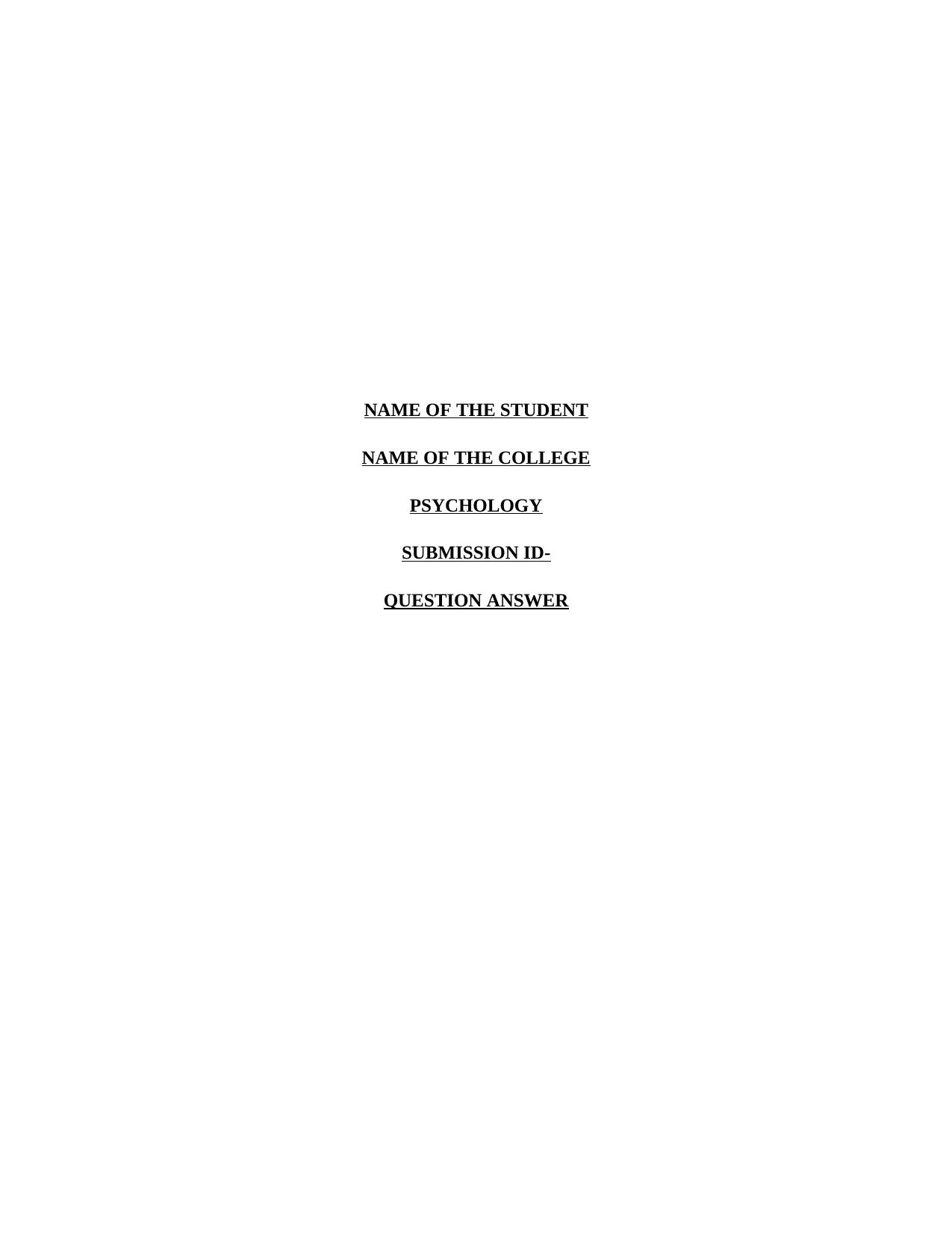
NAME OF THE STUDENT
NAME OF THE COLLEGE
PSYCHOLOGY
SUBMISSION ID-
QUESTION ANSWER
NAME OF THE COLLEGE
PSYCHOLOGY
SUBMISSION ID-
QUESTION ANSWER
Paraphrase This Document
Need a fresh take? Get an instant paraphrase of this document with our AI Paraphraser
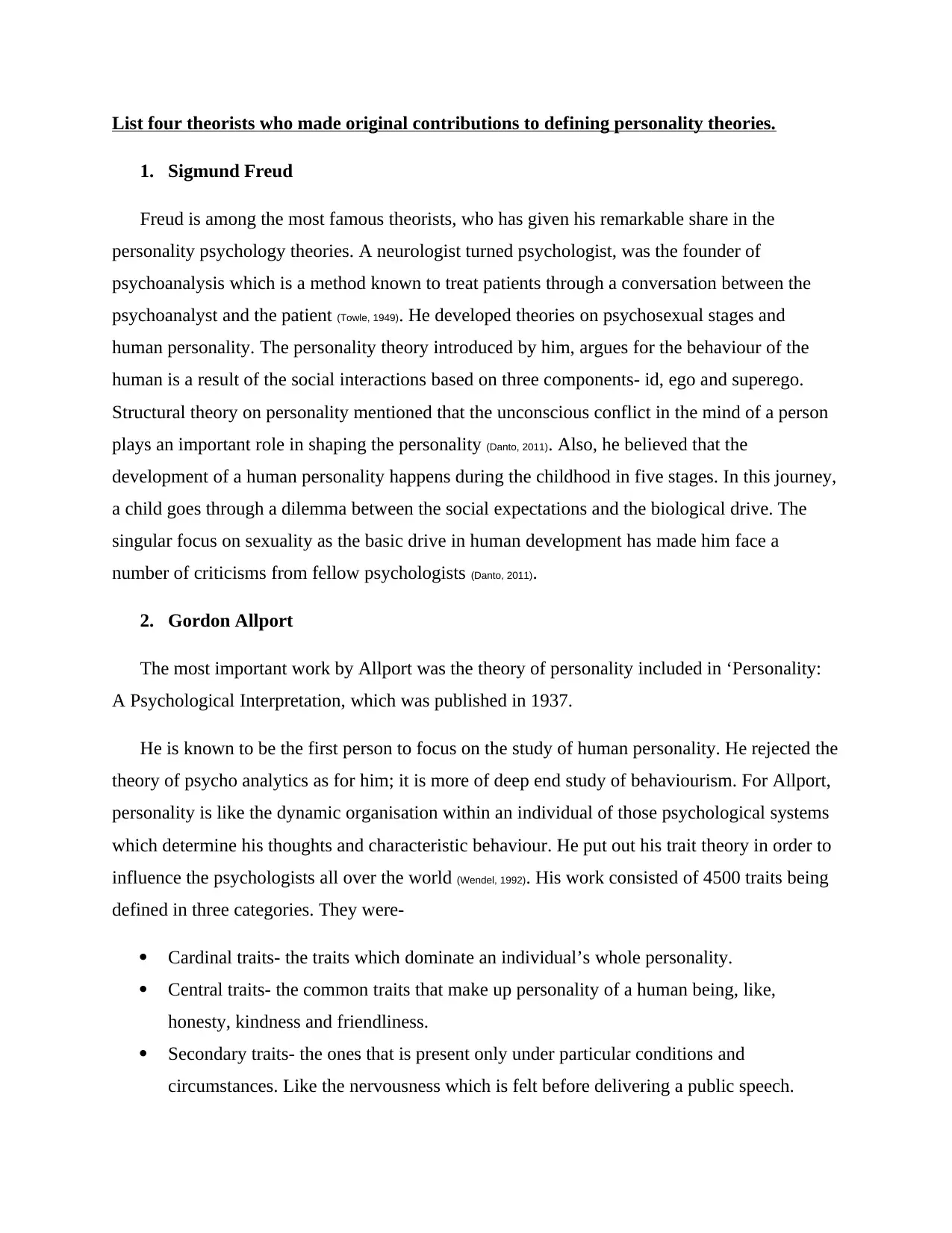
List four theorists who made original contributions to defining personality theories.
1. Sigmund Freud
Freud is among the most famous theorists, who has given his remarkable share in the
personality psychology theories. A neurologist turned psychologist, was the founder of
psychoanalysis which is a method known to treat patients through a conversation between the
psychoanalyst and the patient (Towle, 1949). He developed theories on psychosexual stages and
human personality. The personality theory introduced by him, argues for the behaviour of the
human is a result of the social interactions based on three components- id, ego and superego.
Structural theory on personality mentioned that the unconscious conflict in the mind of a person
plays an important role in shaping the personality (Danto, 2011). Also, he believed that the
development of a human personality happens during the childhood in five stages. In this journey,
a child goes through a dilemma between the social expectations and the biological drive. The
singular focus on sexuality as the basic drive in human development has made him face a
number of criticisms from fellow psychologists (Danto, 2011).
2. Gordon Allport
The most important work by Allport was the theory of personality included in ‘Personality:
A Psychological Interpretation, which was published in 1937.
He is known to be the first person to focus on the study of human personality. He rejected the
theory of psycho analytics as for him; it is more of deep end study of behaviourism. For Allport,
personality is like the dynamic organisation within an individual of those psychological systems
which determine his thoughts and characteristic behaviour. He put out his trait theory in order to
influence the psychologists all over the world (Wendel, 1992). His work consisted of 4500 traits being
defined in three categories. They were-
Cardinal traits- the traits which dominate an individual’s whole personality.
Central traits- the common traits that make up personality of a human being, like,
honesty, kindness and friendliness.
Secondary traits- the ones that is present only under particular conditions and
circumstances. Like the nervousness which is felt before delivering a public speech.
1. Sigmund Freud
Freud is among the most famous theorists, who has given his remarkable share in the
personality psychology theories. A neurologist turned psychologist, was the founder of
psychoanalysis which is a method known to treat patients through a conversation between the
psychoanalyst and the patient (Towle, 1949). He developed theories on psychosexual stages and
human personality. The personality theory introduced by him, argues for the behaviour of the
human is a result of the social interactions based on three components- id, ego and superego.
Structural theory on personality mentioned that the unconscious conflict in the mind of a person
plays an important role in shaping the personality (Danto, 2011). Also, he believed that the
development of a human personality happens during the childhood in five stages. In this journey,
a child goes through a dilemma between the social expectations and the biological drive. The
singular focus on sexuality as the basic drive in human development has made him face a
number of criticisms from fellow psychologists (Danto, 2011).
2. Gordon Allport
The most important work by Allport was the theory of personality included in ‘Personality:
A Psychological Interpretation, which was published in 1937.
He is known to be the first person to focus on the study of human personality. He rejected the
theory of psycho analytics as for him; it is more of deep end study of behaviourism. For Allport,
personality is like the dynamic organisation within an individual of those psychological systems
which determine his thoughts and characteristic behaviour. He put out his trait theory in order to
influence the psychologists all over the world (Wendel, 1992). His work consisted of 4500 traits being
defined in three categories. They were-
Cardinal traits- the traits which dominate an individual’s whole personality.
Central traits- the common traits that make up personality of a human being, like,
honesty, kindness and friendliness.
Secondary traits- the ones that is present only under particular conditions and
circumstances. Like the nervousness which is felt before delivering a public speech.
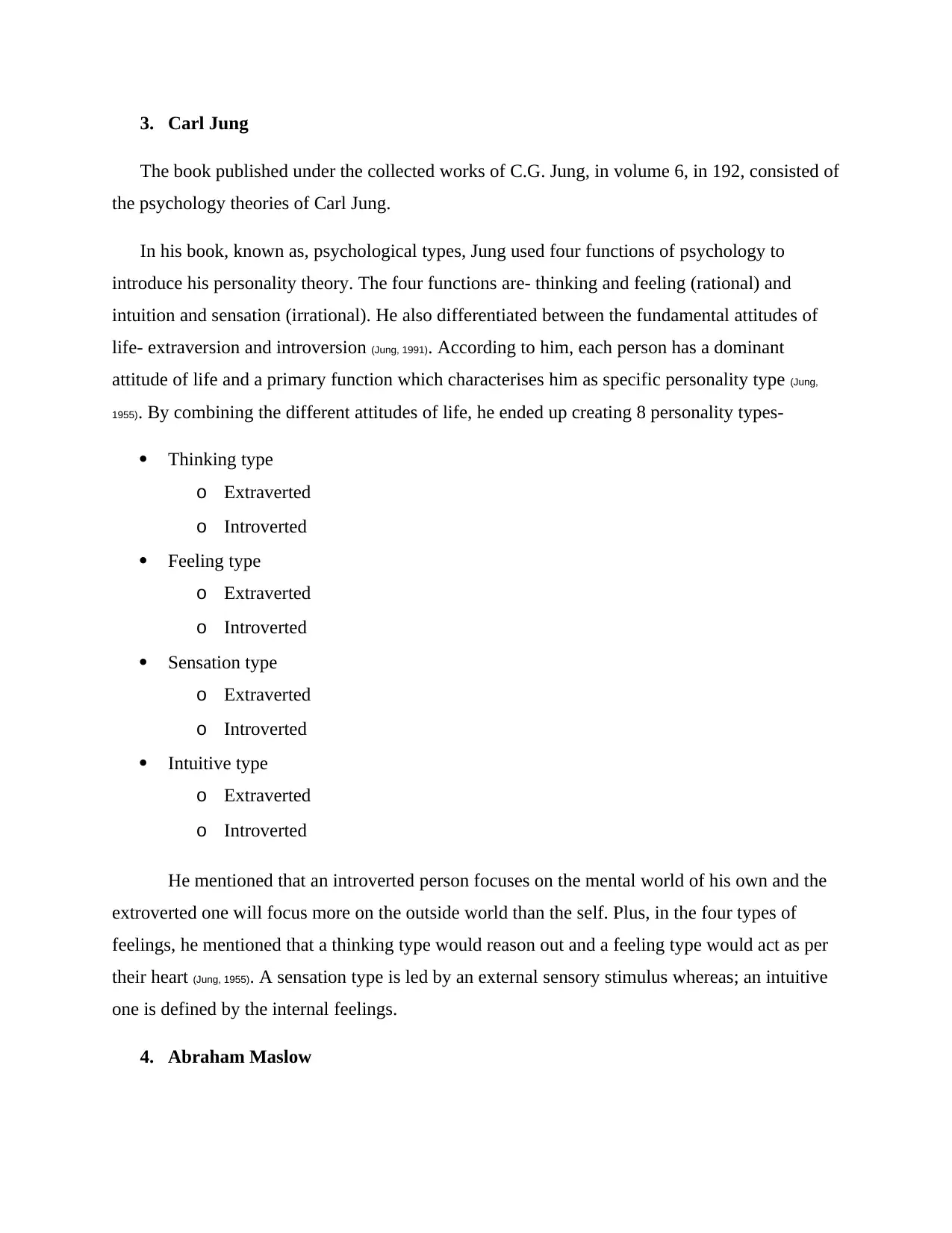
3. Carl Jung
The book published under the collected works of C.G. Jung, in volume 6, in 192, consisted of
the psychology theories of Carl Jung.
In his book, known as, psychological types, Jung used four functions of psychology to
introduce his personality theory. The four functions are- thinking and feeling (rational) and
intuition and sensation (irrational). He also differentiated between the fundamental attitudes of
life- extraversion and introversion (Jung, 1991). According to him, each person has a dominant
attitude of life and a primary function which characterises him as specific personality type (Jung,
1955). By combining the different attitudes of life, he ended up creating 8 personality types-
Thinking type
o Extraverted
o Introverted
Feeling type
o Extraverted
o Introverted
Sensation type
o Extraverted
o Introverted
Intuitive type
o Extraverted
o Introverted
He mentioned that an introverted person focuses on the mental world of his own and the
extroverted one will focus more on the outside world than the self. Plus, in the four types of
feelings, he mentioned that a thinking type would reason out and a feeling type would act as per
their heart (Jung, 1955). A sensation type is led by an external sensory stimulus whereas; an intuitive
one is defined by the internal feelings.
4. Abraham Maslow
The book published under the collected works of C.G. Jung, in volume 6, in 192, consisted of
the psychology theories of Carl Jung.
In his book, known as, psychological types, Jung used four functions of psychology to
introduce his personality theory. The four functions are- thinking and feeling (rational) and
intuition and sensation (irrational). He also differentiated between the fundamental attitudes of
life- extraversion and introversion (Jung, 1991). According to him, each person has a dominant
attitude of life and a primary function which characterises him as specific personality type (Jung,
1955). By combining the different attitudes of life, he ended up creating 8 personality types-
Thinking type
o Extraverted
o Introverted
Feeling type
o Extraverted
o Introverted
Sensation type
o Extraverted
o Introverted
Intuitive type
o Extraverted
o Introverted
He mentioned that an introverted person focuses on the mental world of his own and the
extroverted one will focus more on the outside world than the self. Plus, in the four types of
feelings, he mentioned that a thinking type would reason out and a feeling type would act as per
their heart (Jung, 1955). A sensation type is led by an external sensory stimulus whereas; an intuitive
one is defined by the internal feelings.
4. Abraham Maslow
⊘ This is a preview!⊘
Do you want full access?
Subscribe today to unlock all pages.

Trusted by 1+ million students worldwide
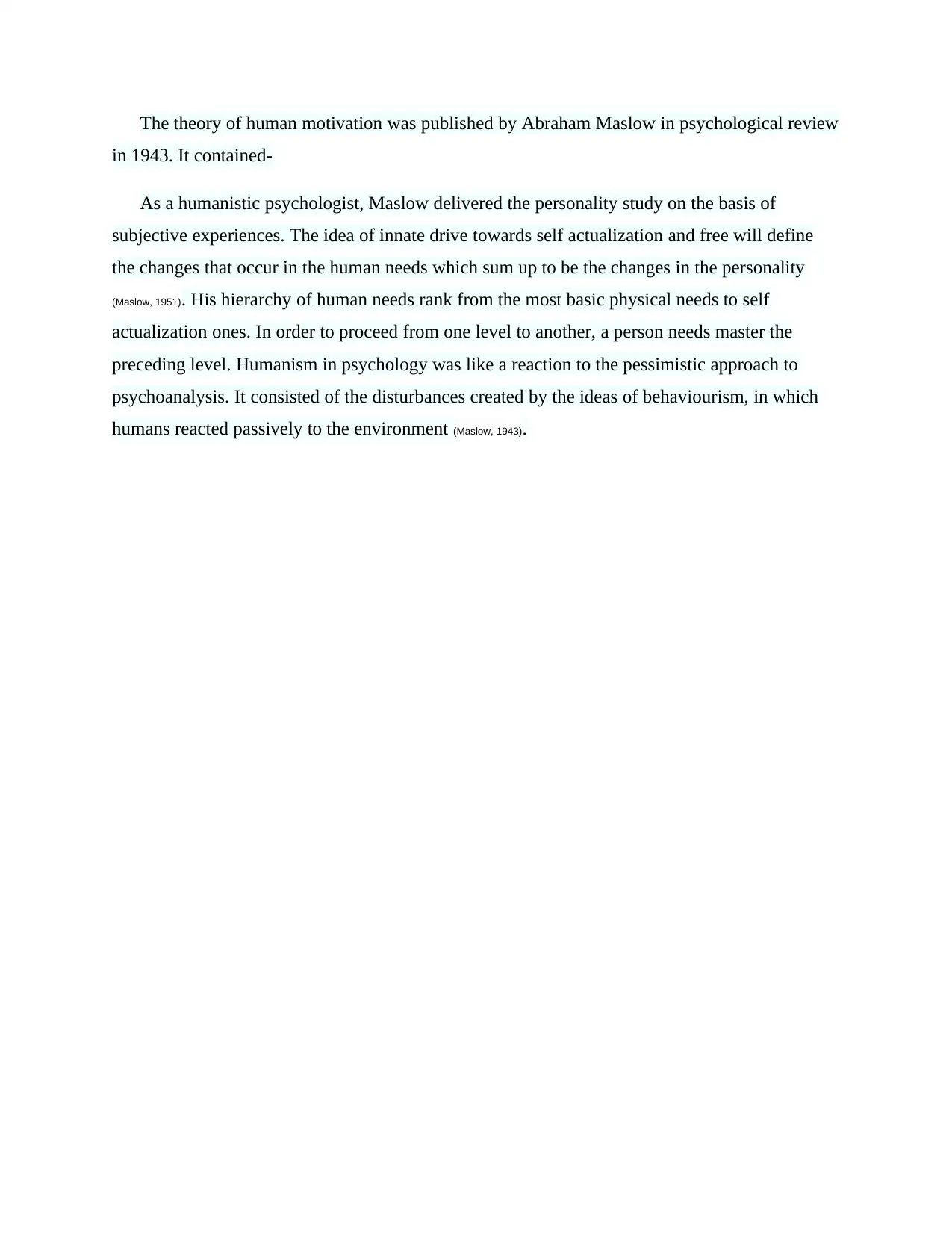
The theory of human motivation was published by Abraham Maslow in psychological review
in 1943. It contained-
As a humanistic psychologist, Maslow delivered the personality study on the basis of
subjective experiences. The idea of innate drive towards self actualization and free will define
the changes that occur in the human needs which sum up to be the changes in the personality
(Maslow, 1951). His hierarchy of human needs rank from the most basic physical needs to self
actualization ones. In order to proceed from one level to another, a person needs master the
preceding level. Humanism in psychology was like a reaction to the pessimistic approach to
psychoanalysis. It consisted of the disturbances created by the ideas of behaviourism, in which
humans reacted passively to the environment (Maslow, 1943).
in 1943. It contained-
As a humanistic psychologist, Maslow delivered the personality study on the basis of
subjective experiences. The idea of innate drive towards self actualization and free will define
the changes that occur in the human needs which sum up to be the changes in the personality
(Maslow, 1951). His hierarchy of human needs rank from the most basic physical needs to self
actualization ones. In order to proceed from one level to another, a person needs master the
preceding level. Humanism in psychology was like a reaction to the pessimistic approach to
psychoanalysis. It consisted of the disturbances created by the ideas of behaviourism, in which
humans reacted passively to the environment (Maslow, 1943).
Paraphrase This Document
Need a fresh take? Get an instant paraphrase of this document with our AI Paraphraser
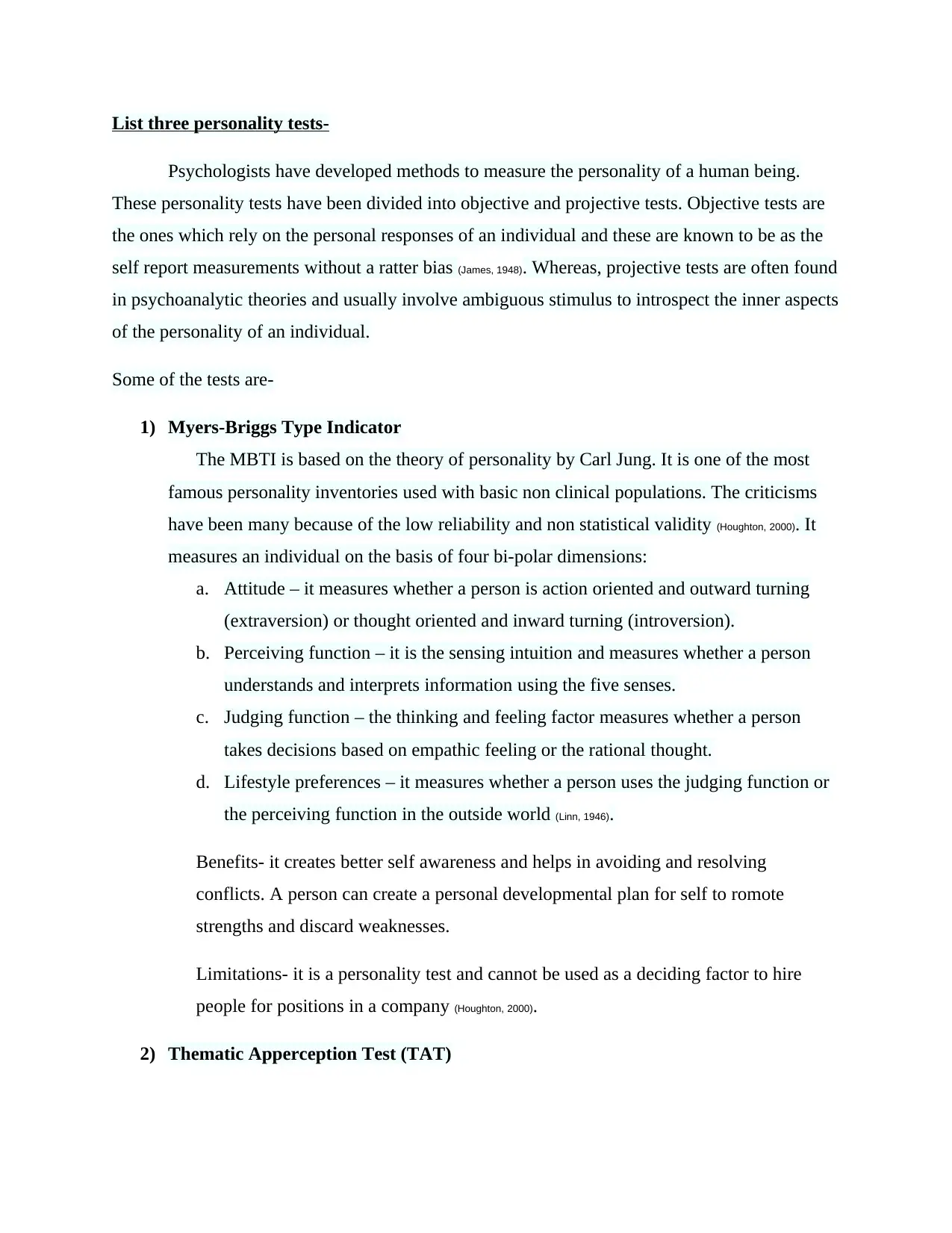
List three personality tests-
Psychologists have developed methods to measure the personality of a human being.
These personality tests have been divided into objective and projective tests. Objective tests are
the ones which rely on the personal responses of an individual and these are known to be as the
self report measurements without a ratter bias (James, 1948). Whereas, projective tests are often found
in psychoanalytic theories and usually involve ambiguous stimulus to introspect the inner aspects
of the personality of an individual.
Some of the tests are-
1) Myers-Briggs Type Indicator
The MBTI is based on the theory of personality by Carl Jung. It is one of the most
famous personality inventories used with basic non clinical populations. The criticisms
have been many because of the low reliability and non statistical validity (Houghton, 2000). It
measures an individual on the basis of four bi-polar dimensions:
a. Attitude – it measures whether a person is action oriented and outward turning
(extraversion) or thought oriented and inward turning (introversion).
b. Perceiving function – it is the sensing intuition and measures whether a person
understands and interprets information using the five senses.
c. Judging function – the thinking and feeling factor measures whether a person
takes decisions based on empathic feeling or the rational thought.
d. Lifestyle preferences – it measures whether a person uses the judging function or
the perceiving function in the outside world (Linn, 1946).
Benefits- it creates better self awareness and helps in avoiding and resolving
conflicts. A person can create a personal developmental plan for self to romote
strengths and discard weaknesses.
Limitations- it is a personality test and cannot be used as a deciding factor to hire
people for positions in a company (Houghton, 2000).
2) Thematic Apperception Test (TAT)
Psychologists have developed methods to measure the personality of a human being.
These personality tests have been divided into objective and projective tests. Objective tests are
the ones which rely on the personal responses of an individual and these are known to be as the
self report measurements without a ratter bias (James, 1948). Whereas, projective tests are often found
in psychoanalytic theories and usually involve ambiguous stimulus to introspect the inner aspects
of the personality of an individual.
Some of the tests are-
1) Myers-Briggs Type Indicator
The MBTI is based on the theory of personality by Carl Jung. It is one of the most
famous personality inventories used with basic non clinical populations. The criticisms
have been many because of the low reliability and non statistical validity (Houghton, 2000). It
measures an individual on the basis of four bi-polar dimensions:
a. Attitude – it measures whether a person is action oriented and outward turning
(extraversion) or thought oriented and inward turning (introversion).
b. Perceiving function – it is the sensing intuition and measures whether a person
understands and interprets information using the five senses.
c. Judging function – the thinking and feeling factor measures whether a person
takes decisions based on empathic feeling or the rational thought.
d. Lifestyle preferences – it measures whether a person uses the judging function or
the perceiving function in the outside world (Linn, 1946).
Benefits- it creates better self awareness and helps in avoiding and resolving
conflicts. A person can create a personal developmental plan for self to romote
strengths and discard weaknesses.
Limitations- it is a personality test and cannot be used as a deciding factor to hire
people for positions in a company (Houghton, 2000).
2) Thematic Apperception Test (TAT)
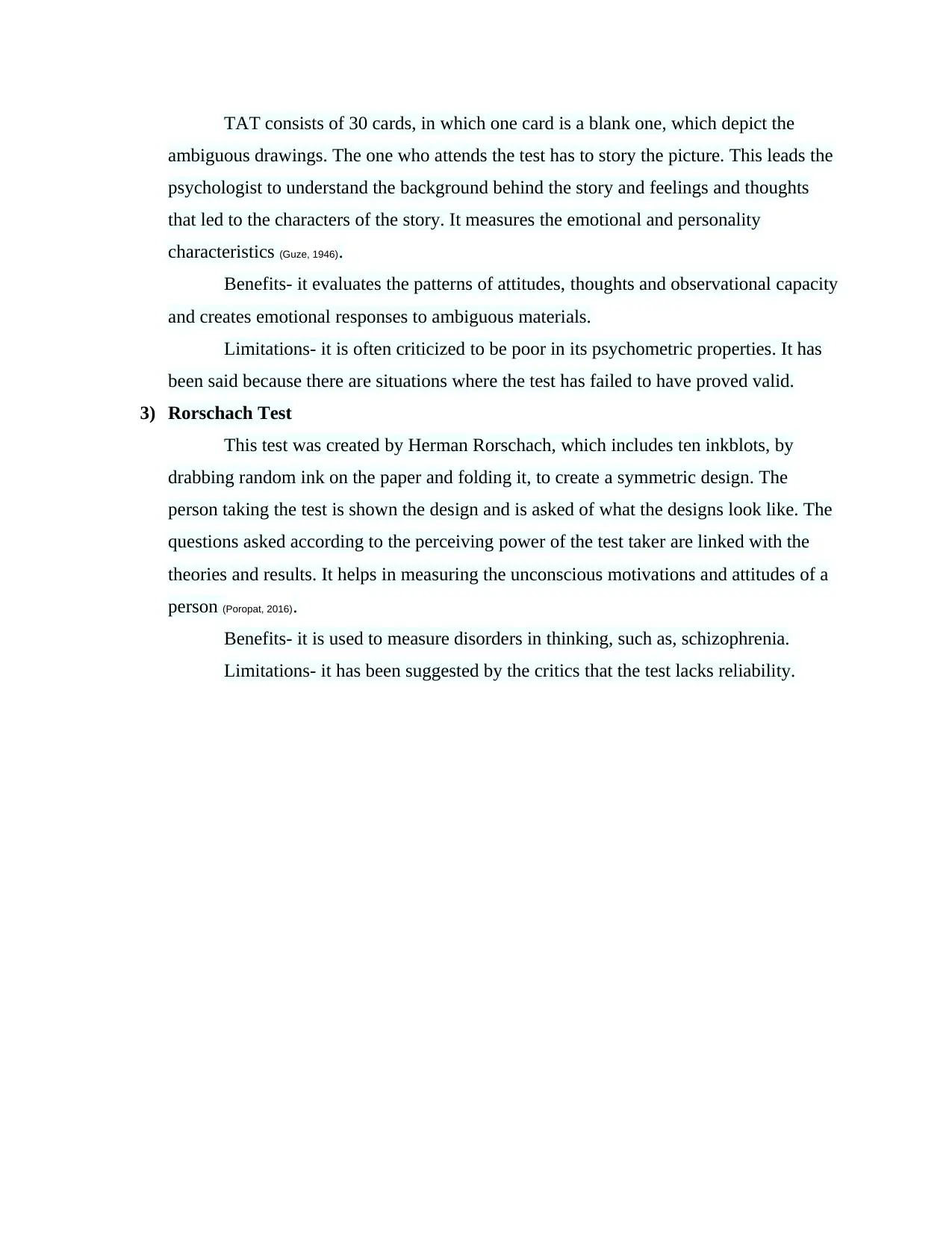
TAT consists of 30 cards, in which one card is a blank one, which depict the
ambiguous drawings. The one who attends the test has to story the picture. This leads the
psychologist to understand the background behind the story and feelings and thoughts
that led to the characters of the story. It measures the emotional and personality
characteristics (Guze, 1946).
Benefits- it evaluates the patterns of attitudes, thoughts and observational capacity
and creates emotional responses to ambiguous materials.
Limitations- it is often criticized to be poor in its psychometric properties. It has
been said because there are situations where the test has failed to have proved valid.
3) Rorschach Test
This test was created by Herman Rorschach, which includes ten inkblots, by
drabbing random ink on the paper and folding it, to create a symmetric design. The
person taking the test is shown the design and is asked of what the designs look like. The
questions asked according to the perceiving power of the test taker are linked with the
theories and results. It helps in measuring the unconscious motivations and attitudes of a
person (Poropat, 2016).
Benefits- it is used to measure disorders in thinking, such as, schizophrenia.
Limitations- it has been suggested by the critics that the test lacks reliability.
ambiguous drawings. The one who attends the test has to story the picture. This leads the
psychologist to understand the background behind the story and feelings and thoughts
that led to the characters of the story. It measures the emotional and personality
characteristics (Guze, 1946).
Benefits- it evaluates the patterns of attitudes, thoughts and observational capacity
and creates emotional responses to ambiguous materials.
Limitations- it is often criticized to be poor in its psychometric properties. It has
been said because there are situations where the test has failed to have proved valid.
3) Rorschach Test
This test was created by Herman Rorschach, which includes ten inkblots, by
drabbing random ink on the paper and folding it, to create a symmetric design. The
person taking the test is shown the design and is asked of what the designs look like. The
questions asked according to the perceiving power of the test taker are linked with the
theories and results. It helps in measuring the unconscious motivations and attitudes of a
person (Poropat, 2016).
Benefits- it is used to measure disorders in thinking, such as, schizophrenia.
Limitations- it has been suggested by the critics that the test lacks reliability.
⊘ This is a preview!⊘
Do you want full access?
Subscribe today to unlock all pages.

Trusted by 1+ million students worldwide
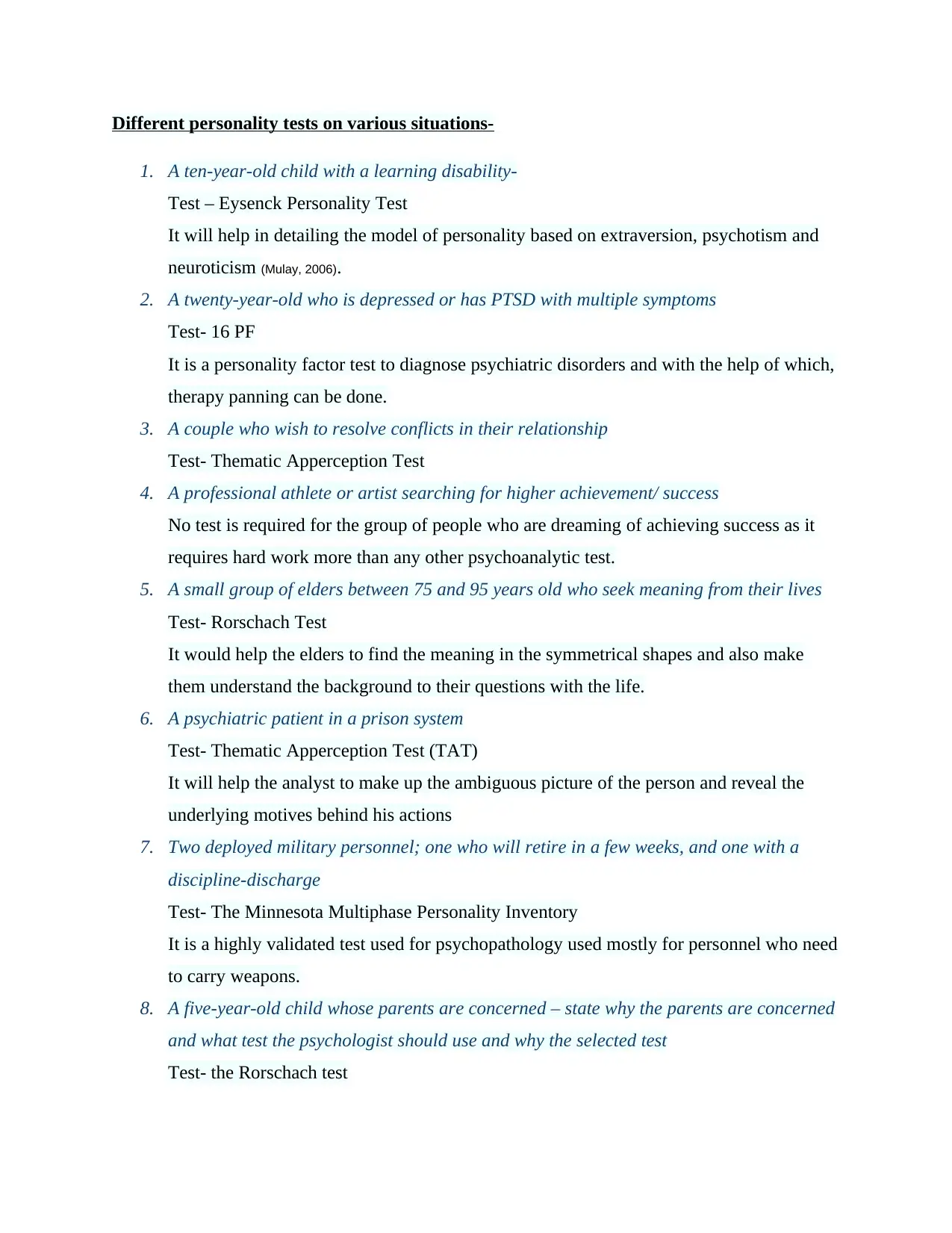
Different personality tests on various situations-
1. A ten-year-old child with a learning disability-
Test – Eysenck Personality Test
It will help in detailing the model of personality based on extraversion, psychotism and
neuroticism (Mulay, 2006).
2. A twenty-year-old who is depressed or has PTSD with multiple symptoms
Test- 16 PF
It is a personality factor test to diagnose psychiatric disorders and with the help of which,
therapy panning can be done.
3. A couple who wish to resolve conflicts in their relationship
Test- Thematic Apperception Test
4. A professional athlete or artist searching for higher achievement/ success
No test is required for the group of people who are dreaming of achieving success as it
requires hard work more than any other psychoanalytic test.
5. A small group of elders between 75 and 95 years old who seek meaning from their lives
Test- Rorschach Test
It would help the elders to find the meaning in the symmetrical shapes and also make
them understand the background to their questions with the life.
6. A psychiatric patient in a prison system
Test- Thematic Apperception Test (TAT)
It will help the analyst to make up the ambiguous picture of the person and reveal the
underlying motives behind his actions
7. Two deployed military personnel; one who will retire in a few weeks, and one with a
discipline-discharge
Test- The Minnesota Multiphase Personality Inventory
It is a highly validated test used for psychopathology used mostly for personnel who need
to carry weapons.
8. A five-year-old child whose parents are concerned – state why the parents are concerned
and what test the psychologist should use and why the selected test
Test- the Rorschach test
1. A ten-year-old child with a learning disability-
Test – Eysenck Personality Test
It will help in detailing the model of personality based on extraversion, psychotism and
neuroticism (Mulay, 2006).
2. A twenty-year-old who is depressed or has PTSD with multiple symptoms
Test- 16 PF
It is a personality factor test to diagnose psychiatric disorders and with the help of which,
therapy panning can be done.
3. A couple who wish to resolve conflicts in their relationship
Test- Thematic Apperception Test
4. A professional athlete or artist searching for higher achievement/ success
No test is required for the group of people who are dreaming of achieving success as it
requires hard work more than any other psychoanalytic test.
5. A small group of elders between 75 and 95 years old who seek meaning from their lives
Test- Rorschach Test
It would help the elders to find the meaning in the symmetrical shapes and also make
them understand the background to their questions with the life.
6. A psychiatric patient in a prison system
Test- Thematic Apperception Test (TAT)
It will help the analyst to make up the ambiguous picture of the person and reveal the
underlying motives behind his actions
7. Two deployed military personnel; one who will retire in a few weeks, and one with a
discipline-discharge
Test- The Minnesota Multiphase Personality Inventory
It is a highly validated test used for psychopathology used mostly for personnel who need
to carry weapons.
8. A five-year-old child whose parents are concerned – state why the parents are concerned
and what test the psychologist should use and why the selected test
Test- the Rorschach test
Paraphrase This Document
Need a fresh take? Get an instant paraphrase of this document with our AI Paraphraser
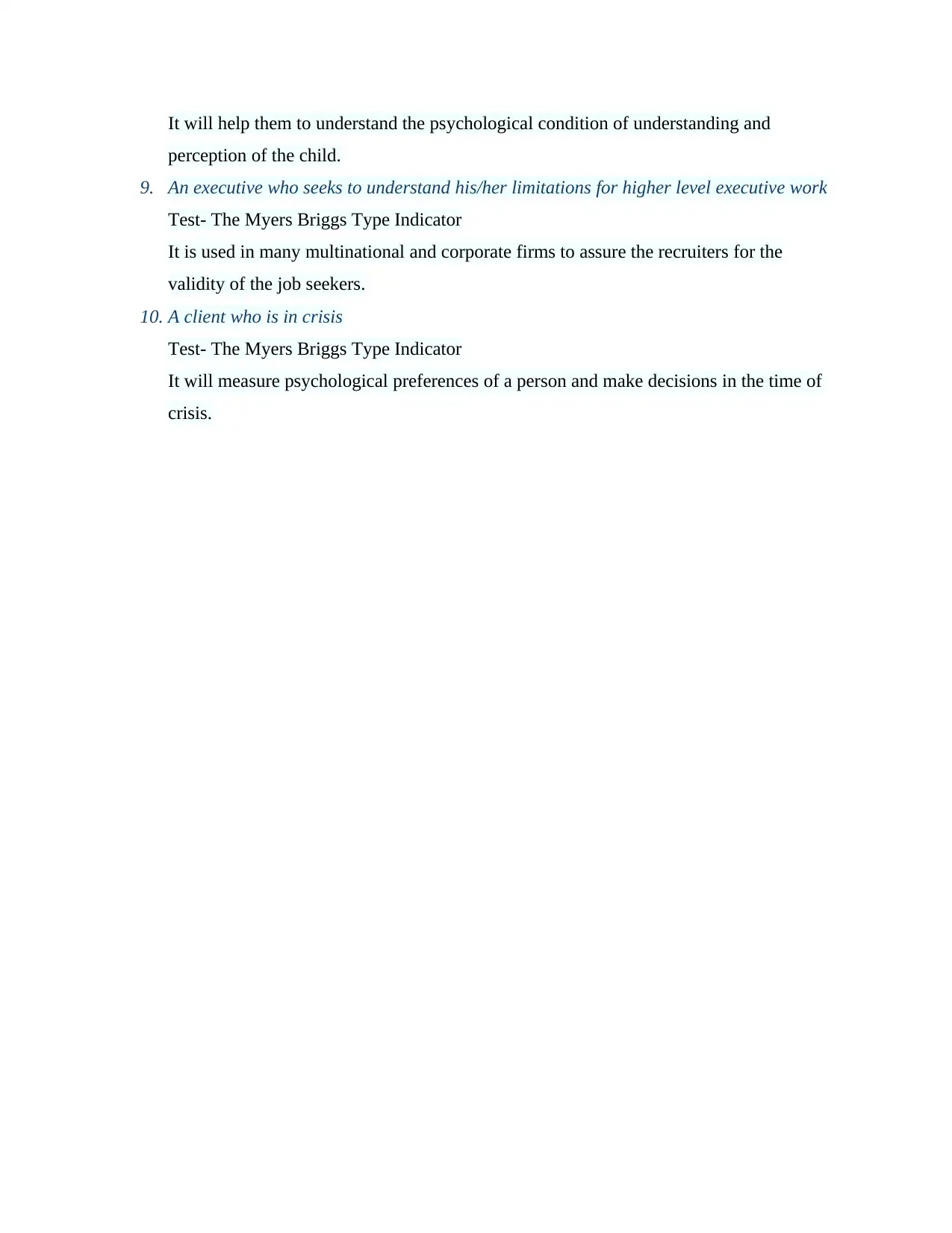
It will help them to understand the psychological condition of understanding and
perception of the child.
9. An executive who seeks to understand his/her limitations for higher level executive work
Test- The Myers Briggs Type Indicator
It is used in many multinational and corporate firms to assure the recruiters for the
validity of the job seekers.
10. A client who is in crisis
Test- The Myers Briggs Type Indicator
It will measure psychological preferences of a person and make decisions in the time of
crisis.
perception of the child.
9. An executive who seeks to understand his/her limitations for higher level executive work
Test- The Myers Briggs Type Indicator
It is used in many multinational and corporate firms to assure the recruiters for the
validity of the job seekers.
10. A client who is in crisis
Test- The Myers Briggs Type Indicator
It will measure psychological preferences of a person and make decisions in the time of
crisis.
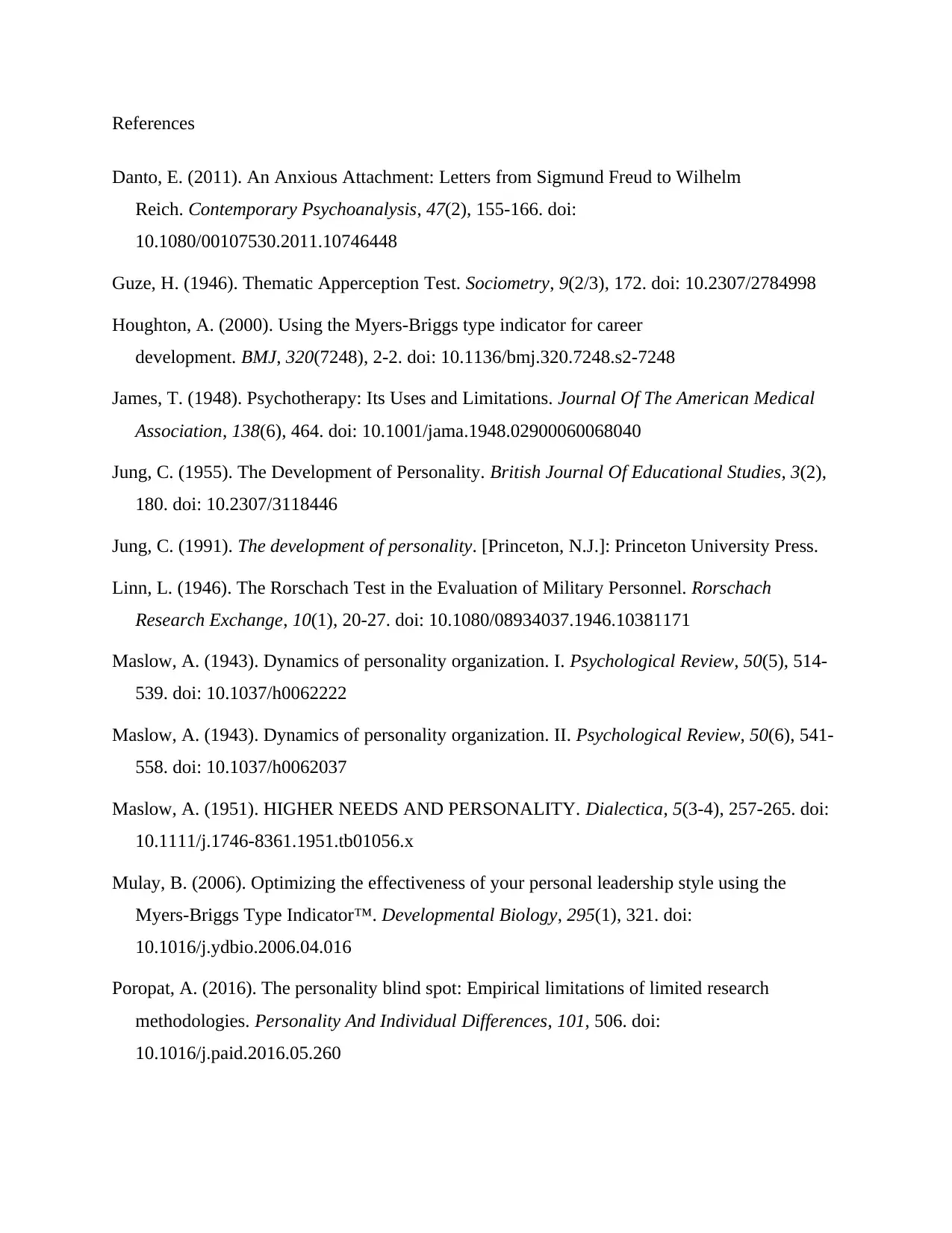
References
Danto, E. (2011). An Anxious Attachment: Letters from Sigmund Freud to Wilhelm
Reich. Contemporary Psychoanalysis, 47(2), 155-166. doi:
10.1080/00107530.2011.10746448
Guze, H. (1946). Thematic Apperception Test. Sociometry, 9(2/3), 172. doi: 10.2307/2784998
Houghton, A. (2000). Using the Myers-Briggs type indicator for career
development. BMJ, 320(7248), 2-2. doi: 10.1136/bmj.320.7248.s2-7248
James, T. (1948). Psychotherapy: Its Uses and Limitations. Journal Of The American Medical
Association, 138(6), 464. doi: 10.1001/jama.1948.02900060068040
Jung, C. (1955). The Development of Personality. British Journal Of Educational Studies, 3(2),
180. doi: 10.2307/3118446
Jung, C. (1991). The development of personality. [Princeton, N.J.]: Princeton University Press.
Linn, L. (1946). The Rorschach Test in the Evaluation of Military Personnel. Rorschach
Research Exchange, 10(1), 20-27. doi: 10.1080/08934037.1946.10381171
Maslow, A. (1943). Dynamics of personality organization. I. Psychological Review, 50(5), 514-
539. doi: 10.1037/h0062222
Maslow, A. (1943). Dynamics of personality organization. II. Psychological Review, 50(6), 541-
558. doi: 10.1037/h0062037
Maslow, A. (1951). HIGHER NEEDS AND PERSONALITY. Dialectica, 5(3-4), 257-265. doi:
10.1111/j.1746-8361.1951.tb01056.x
Mulay, B. (2006). Optimizing the effectiveness of your personal leadership style using the
Myers-Briggs Type Indicator™. Developmental Biology, 295(1), 321. doi:
10.1016/j.ydbio.2006.04.016
Poropat, A. (2016). The personality blind spot: Empirical limitations of limited research
methodologies. Personality And Individual Differences, 101, 506. doi:
10.1016/j.paid.2016.05.260
Danto, E. (2011). An Anxious Attachment: Letters from Sigmund Freud to Wilhelm
Reich. Contemporary Psychoanalysis, 47(2), 155-166. doi:
10.1080/00107530.2011.10746448
Guze, H. (1946). Thematic Apperception Test. Sociometry, 9(2/3), 172. doi: 10.2307/2784998
Houghton, A. (2000). Using the Myers-Briggs type indicator for career
development. BMJ, 320(7248), 2-2. doi: 10.1136/bmj.320.7248.s2-7248
James, T. (1948). Psychotherapy: Its Uses and Limitations. Journal Of The American Medical
Association, 138(6), 464. doi: 10.1001/jama.1948.02900060068040
Jung, C. (1955). The Development of Personality. British Journal Of Educational Studies, 3(2),
180. doi: 10.2307/3118446
Jung, C. (1991). The development of personality. [Princeton, N.J.]: Princeton University Press.
Linn, L. (1946). The Rorschach Test in the Evaluation of Military Personnel. Rorschach
Research Exchange, 10(1), 20-27. doi: 10.1080/08934037.1946.10381171
Maslow, A. (1943). Dynamics of personality organization. I. Psychological Review, 50(5), 514-
539. doi: 10.1037/h0062222
Maslow, A. (1943). Dynamics of personality organization. II. Psychological Review, 50(6), 541-
558. doi: 10.1037/h0062037
Maslow, A. (1951). HIGHER NEEDS AND PERSONALITY. Dialectica, 5(3-4), 257-265. doi:
10.1111/j.1746-8361.1951.tb01056.x
Mulay, B. (2006). Optimizing the effectiveness of your personal leadership style using the
Myers-Briggs Type Indicator™. Developmental Biology, 295(1), 321. doi:
10.1016/j.ydbio.2006.04.016
Poropat, A. (2016). The personality blind spot: Empirical limitations of limited research
methodologies. Personality And Individual Differences, 101, 506. doi:
10.1016/j.paid.2016.05.260
⊘ This is a preview!⊘
Do you want full access?
Subscribe today to unlock all pages.

Trusted by 1+ million students worldwide
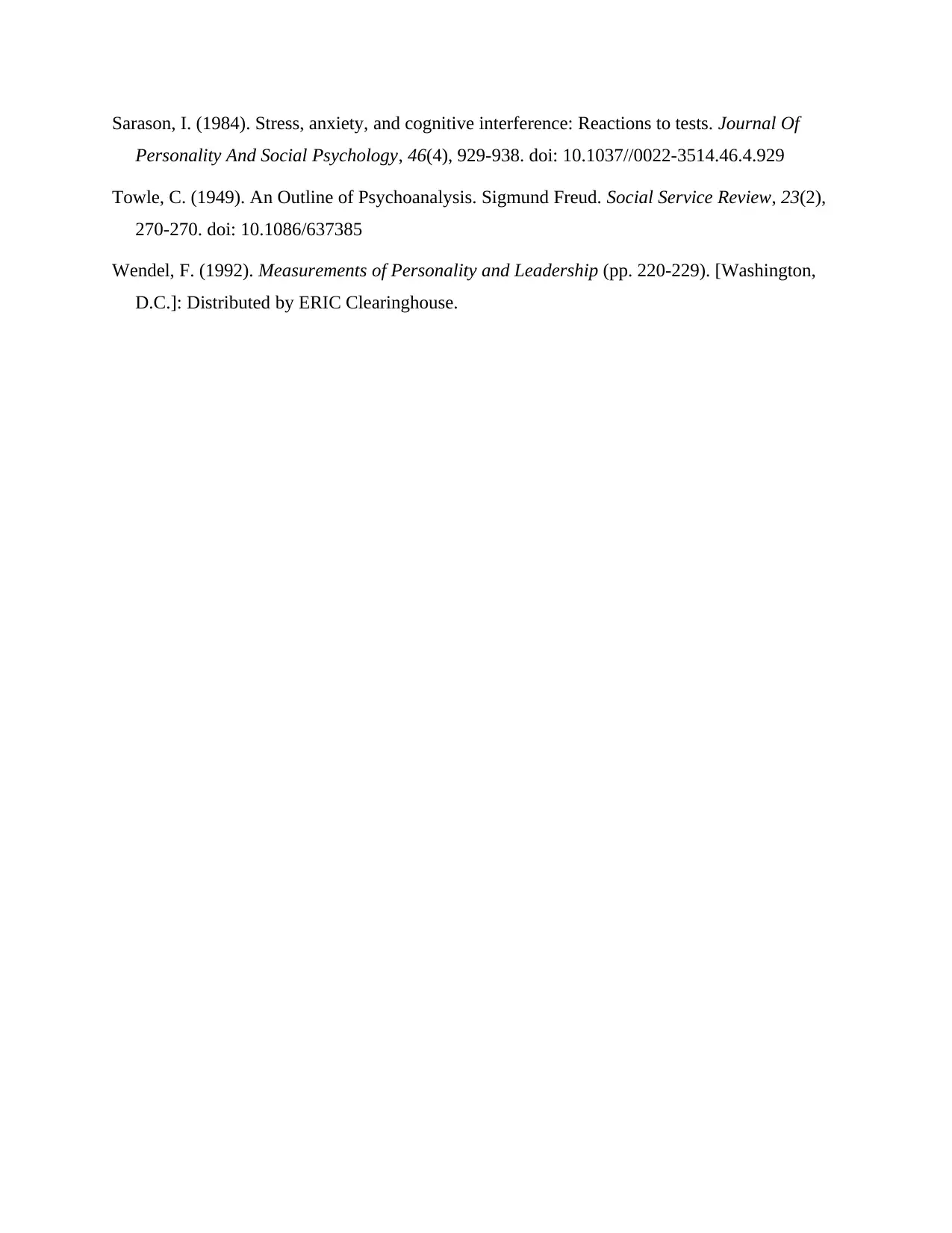
Sarason, I. (1984). Stress, anxiety, and cognitive interference: Reactions to tests. Journal Of
Personality And Social Psychology, 46(4), 929-938. doi: 10.1037//0022-3514.46.4.929
Towle, C. (1949). An Outline of Psychoanalysis. Sigmund Freud. Social Service Review, 23(2),
270-270. doi: 10.1086/637385
Wendel, F. (1992). Measurements of Personality and Leadership (pp. 220-229). [Washington,
D.C.]: Distributed by ERIC Clearinghouse.
Personality And Social Psychology, 46(4), 929-938. doi: 10.1037//0022-3514.46.4.929
Towle, C. (1949). An Outline of Psychoanalysis. Sigmund Freud. Social Service Review, 23(2),
270-270. doi: 10.1086/637385
Wendel, F. (1992). Measurements of Personality and Leadership (pp. 220-229). [Washington,
D.C.]: Distributed by ERIC Clearinghouse.
1 out of 10
Related Documents
Your All-in-One AI-Powered Toolkit for Academic Success.
+13062052269
info@desklib.com
Available 24*7 on WhatsApp / Email
![[object Object]](/_next/static/media/star-bottom.7253800d.svg)
Unlock your academic potential
Copyright © 2020–2025 A2Z Services. All Rights Reserved. Developed and managed by ZUCOL.





